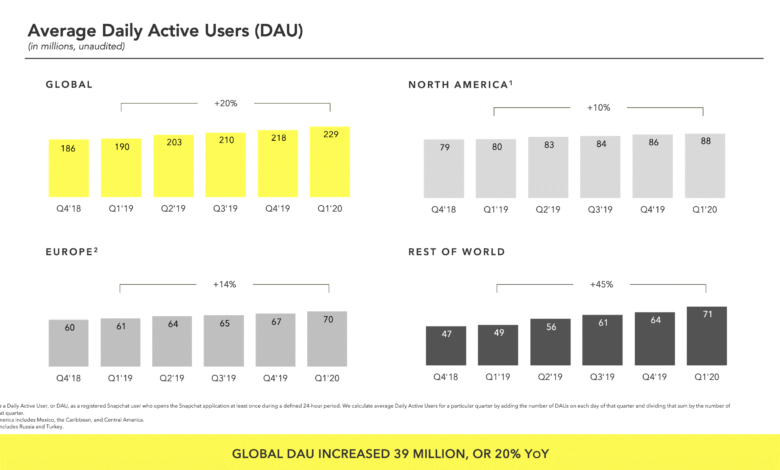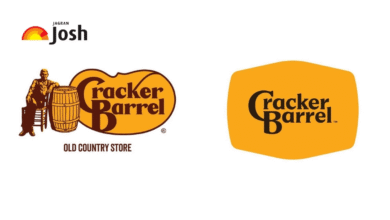Snap Earnings Report: Q1 Results and Future Outlook

Snap earnings report revealed a mixed performance for the company in the first quarter, with analysts witnessing a better-than-expected revenue of $1.36 billion despite ongoing challenges in advertising demand. However, Snap Inc faced hurdles, reporting a loss of 8 cents per share while navigating macroeconomic uncertainties that may impact future growth. Shares dipped 13% in after-hours trading following the announcement, reflecting investor concerns regarding Snap’s financial guidance amid declining advertising demand. While global daily users climbed to 460 million, signaling user growth, the decline in brand-focused advertising revenue poses potential risks for Snap’s overall financial health. As competition heats up in the tech sector, Snap’s strategies and adaptations will be pivotal in overcoming these obstacles and repositioning itself in the market.
In their latest quarterly summary, Snap Inc delivered a blend of constructive and worrying signals for stakeholders, highlighting tighter-than-expected revenues amid softening demand for advertisements. The financial commentary underscored a notable shift as the company addressed financial guidance, which remains nebulous due to external market influences. Notably, Snap reported sustained user engagement, with an increase in active users, while also disclosing cuts to forecasted advertising revenue streams. In light of recent economic shifts, Snap’s latest revenue insights and user engagement metrics come at a crucial time, as they may hint at the company’s adaptive strategies and long-term viability. By balancing between operational cutbacks and user growth, Snap is poised to navigate the challenges that lie ahead.
Snap Earnings Report: An Overview of Q1 Performance
Snap Inc. released its Q1 earnings report, showcasing a revenue of $1.36 billion, narrowly outperforming Wall Street’s expectations of $1.35 billion. Despite this positive headline, the company’s stock saw a significant drop of 13% in after-hours trading, highlighting investor concerns over future growth amidst macroeconomic uncertainties. Notably, Snap reported a loss of 8 cents per share, which falls short of comparability with analyst projections, raising questions about its profitability in a competitive market.
The earnings report also indicated a slight growth in global daily active users, reaching 460 million against predictions of 459 million. This user growth is essential for Snap, especially considering the intense competition from other social media platforms. The company highlighted that while user engagement is evolving positively, fluctuating economic conditions challenge their advertising demand, making it essential for Snap to navigate these challenges prudently.
The Impact of Advertising Demand on Snap’s Future
Snap’s future largely hinges on advertising demand, which has been impacted by various macroeconomic factors. As noted in Snap’s earnings report, there are significant uncertainties that could disrupt advertising revenue streams. The potential end of the de minimis exemption, which allows low-value shipments to enter the U.S. duty-free, has also raised concerns among advertisers, further complicating the landscape of digital advertising.
The report revealed that Snap’s advertising revenue had grown 9% year over year to $1.21 billion, primarily powered by direct response advertising. However, brand-focused advertising saw a decline of 3%, suggesting that while direct response strategies are proving effective, broader brand campaigns are struggling in the current economic climate. Snap’s capacity to adapt its advertising strategies in response to these market demands will be critical for maintaining user engagement and driving revenues in the quarters ahead.
Understanding Snap’s revenue decline in specific sectors while witnessing a rise in other areas allows stakeholders to gauge the company’s adaptability. As competition intensifies, Snap must refine its approach to maximizing advertising impact, particularly in unstable economic conditions.
Analyzing Snap’s User Base Growth and Future Prospects
Despite economic pressures, Snap has managed to increase its daily active users, climbing to 460 million from 453 million in the previous quarter. This performance highlights Snap’s ongoing ability to attract and retain users in a saturated market, bolstered further by an impressive jump in monthly active users, which reached 900 million. The rise in subscriptions to Snapchat+ reflects the platform’s growing appeal and potential for revenue diversification beyond traditional ad sales.
However, North American user numbers saw a slight decline, with daily active users dropping from 100 million to 99 million. This illustrates the challenges Snap faces in key markets, where the competition for user attention is fierce. Maintaining user growth in North America while expanding globally will be pivotal for Snap’s success, especially as economic uncertainties loom.
Snap’s Financial Guidance Amidst Economic Uncertainty
In its earnings report, Snap refrained from providing specific financial guidance for the second quarter due to macroeconomic uncertainties that could affect advertising demand. This cautious approach reflects a broader trend among tech companies who are grappling with similar challenges. The company has revised its full-year adjusted operating expenses forecast downward, indicating a strategic pivot towards more conservative financial management in light of evolving market conditions.
Snap also adjusted its stock-based compensation guidance, reducing expectations which may reflect a need to prioritize sustainable growth over aggressive expansion. By fostering a more balanced approach, Snap aims to navigate uncertainties more effectively, potentially positioning itself favorably for long-term recovery despite immediate challenges to revenue and user growth.
The Role of Snapchat+ in Snap’s Revenue Strategy
The success of Snapchat+ has become an important part of Snap’s revenue strategy, boasting over 15 million subscribers, up from 14 million. This subscription service has significantly contributed to the company’s ‘other revenue,’ which posted a remarkable year-over-year increase of 75%. As traditional advertising revenue experiences fluctuations, services like Snapchat+ are essential for diversifying Snap’s income streams.
The growth in subscriptions reflects a shift towards more stable, recurring revenue models. By fostering an engaged community around premium features, Snap can leverage this loyal user base to enhance its overall financial health and reduce reliance on volatile advertising revenues. However, balancing this subscriber growth with traditional ad revenue will remain a critical focus for Snap as they strategize for future growth.
Navigating External Economic Challenges: Snap’s Strategy
External economic challenges pose significant risks to Snap’s financial performance, particularly as the effects of political decisions and trade policies emerge. Derek Andersen, Snap’s finance chief, pointed out that some advertisers reported adverse impacts due to political changes, underscoring the intricate relationship between government policies and digital advertising effectiveness. The shifting landscape requires Snap to remain vigilant and adaptive as it crafts its strategic responses.
To successfully navigate these challenges, Snap must prioritize agility and resilience in its operations. Investing in analytics and building robust advertiser relationships can help mitigate risks and enhance revenue streams. Adjusting advertising strategies in response to external pressures will be crucial in maintaining Snap’s relevancy and competitive edge.
Implications of Snap’s Net Loss for Investors
Snap reported a net loss of approximately $140 million for the quarter, representing a significant decrease from a $305 million loss during the same period the previous year. While a reduction in losses is a positive indicator, investors remain cautious as the company navigates through challenging waters. The contrast between the improvement in adjusted EBITDA—an encouraging figure that surpassed expectations—versus the net loss raises critical questions about Snap’s operational efficiency and long-term profitability prospects.
The financial results reveal a complex narrative for Snap, where operational challenges must be addressed alongside positive user growth metrics. Overall, the financial report paints a mixed picture, urging investors to balance optimism about future user engagement with caution regarding ongoing losses and external economic impacts.
The Future of Snap’s Revenue Model in an Evolving Market
As Snap continues to evolve within a highly competitive technology landscape, its revenue model must adapt to changing user behaviors and preferences. With younger audiences moving towards platforms that offer interactive content and engaging user experiences, Snap’s ability to innovate its revenue streams will be essential for attracting and retaining users. This includes enhancing monetization strategies that leverage both traditional advertising and subscription-based models.
Adapting to these market demands, especially as competitors undergo similar transformations, will dictate Snap’s success in the future. The commitment to refining their user experience through strategic initiatives will be vital to capturing new audiences and retaining existing ones, ultimately forming a sustainable pathway for revenue growth.
Conclusions: Snap’s Path Forward in 2023
In conclusion, Snap’s Q1 earnings report surfaces both positive performance indicators and significant challenges. The quarterly results suggest that while Snap is on the path to recovery in certain aspects such as user growth and alternative revenue streams, it must confront the stark reality of macroeconomic conditions that could hinder advertising demand. As evidenced by the cautious financial guidance, Snap’s leadership is taking a prudent approach in balancing investment and realizing revenue growth.
Moving forward, the intersection of user engagement strategies, diversified revenue models like Snapchat+, and political and economic conditions will shape Snap’s trajectory in 2023. Continuous monitoring and adaptation to this changing landscape will be crucial for the company as it strives to stabilize its financial outlook while meeting the expectations of shareholders and users alike.
Frequently Asked Questions
What were Snap Inc’s first-quarter earnings performance and revenue figures in the Snap earnings report?
In the Snap earnings report for Q1, Snap Inc reported a revenue of $1.36 billion, exceeding Wall Street’s expectation of $1.35 billion. However, the company recorded an earnings loss of 8 cents per share, which is not directly comparable to analyst estimates.
How did Snap’s user growth impact its financial performance in the latest Snap earnings report?
The Snap earnings report reflected a growth in global daily active users, reaching 460 million, slightly above the expected 459 million. This user growth contributed to an increase in the global average revenue per user (ARPU), which was $2.96, surpassing the expected $2.93.
What are the implications of Snap’s advertising demand on its future revenue according to the Snap earnings report?
The Snap earnings report highlighted concerns about advertising demand due to macroeconomic uncertainties, which may affect future revenue. Snap declined to provide a second-quarter revenue guidance, underscoring the unpredictable nature of advertising demand that could challenge revenue growth.
What changes did Snap make to its financial guidance in the latest Snap earnings report?
In the latest Snap earnings report, Snap adjusted its full-year financial guidance, lowering expected operating expenses from $2.70-2.75 billion to $2.65-2.70 billion. The company also decreased its stock-based compensation guidance between $1.13 billion and $1.16 billion.
What were the key factors influencing Snap’s revenue decline in the Snap earnings report?
The Snap earnings report indicated a 9% year-over-year increase in ad revenues, although brand-focused advertising decreased by 3%. Challenges such as macroeconomic conditions and the end of the de minimis exemption affecting advertisers also contributed to the revenue decline.
How did Snap’s restructuring costs affect its earnings as described in the Snap earnings report?
According to the Snap earnings report, Snap posted a net loss of approximately $140 million, largely influenced by a $70.1 million charge related to restructuring costs. This loss does not reflect the overall underlying business performance, as the adjusted EBITDA of $108 million exceeded expectations.
What significance does the growth of the Snapchat+ subscription service have on Snap’s earnings report?
The growth of Snapchat+, which surpassed 15 million subscribers, significantly boosted Snap’s ‘other revenue’, increasing it by 75% year over year to $152 million. This trend indicates an important diversification of revenue streams for Snap amidst fluctuating ad revenues.
What are analysts predicting for Snap’s second-quarter revenue based on the Snap earnings report?
Analysts projected Snap’s second-quarter revenue at $1.39 billion; however, the company did not provide guidance due to concerns over advertising demand amid macroeconomic uncertainties, as highlighted in the Snap earnings report.
| Metric | Snap’s Performance | Wall Street Expectations |
|---|---|---|
| Earnings per share | Loss of 8 cents | Not comparable to estimates |
| Revenue | $1.36 billion | $1.35 billion expected |
| Global daily active users | 460 million | 459 million expected |
| Global average revenue per user | $2.96 | $2.93 expected |
| Ad revenue growth (YoY) | 9% growth to $1.21 billion | |
| Adjusted EBITDA | $108 million | $64 million expected |
Summary
The Snap earnings report for the first quarter has revealed better-than-expected revenue, yet the company has opted not to provide guidance due to macroeconomic uncertainties affecting advertising demand. Despite a significant net loss, Snap demonstrated strong growth in user numbers and adjusted EBITDA, highlighting resilience amid external challenges. As Snap navigates these complex conditions, its performance in the following quarters will be pivotal for investor sentiment and market positioning.




